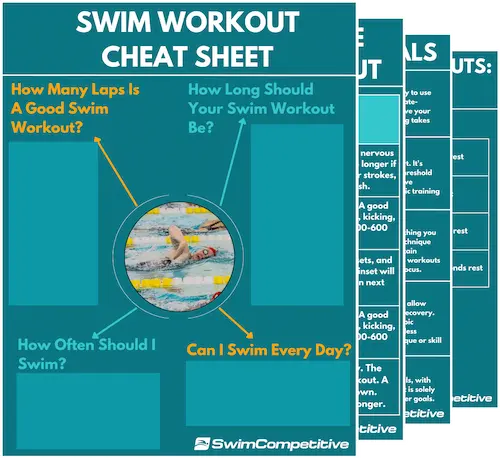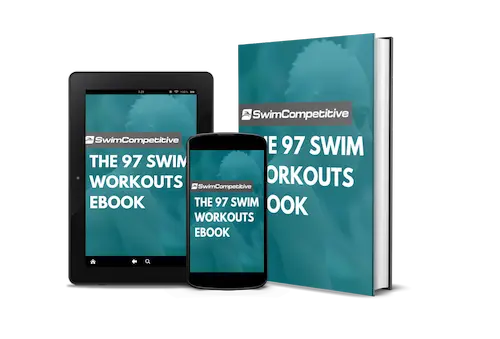Strength and conditioning for swimmers have become an increasingly popular matter in the modern world of competitive swimming.
Strength and conditioning for swimmers can be defined as the physical and physiological development of swimmers for elite and enhanced performance in the water. The role of strength and conditioning is to use exercise to specifically improve performance and speed in the water.
Most elite swimmers today use strength and conditioning training to enhance their physical performance in the water and gain the maximum benefit.
New ways of strength and conditioning are being researched all the time. This is one of the reasons why swimmers are able to continue breaking world records every year. Yes. there are other variables too, like new tech suits and racing goggles.
But at the end of the day, new science is allowing us to train smarter and gain more benefit from our strength and conditioning training as swimmers.
The aim of competitive swimming is for an individual to gain the maximum amount of speed in the water and ultimately win his or her race.
There are many variables that have an outcome on the amount of speed that an individual can produce in the water. One of those variables is strength.
An Overview of Strength in Swimming
Strength can be defined as the physical energy you possess, which allows you the ability to perform various actions such as lifting or moving things.
Ultimately, this comes down to the amount of force you can produce within a certain time span.
However, like most things it isn’t quite that simple. There are many variables of ‘strength’ utilized in competitive swimming.
For example, let’s take a look at 2 types of ‘strength’ in swimming.
The first example is going to include the start or the dive. When a swimmer does a dive they are producing a fast and large amount of energy in order to travel the maximum distance through the air.
During this movement, there is a resistance or force being applied to the swimmer known as gravity. The swimmer has to produce enough power in order to counter gravity or else they won’t be able to jump very far and will be placed at a disadvantage compared to the rest of the field.
The second example that we will look at is when you are actually swimming. Whilst we are swimming our bodies are placed in a horizontal position and we are aiming to travel horizontally and less vertically.
When we are in a horizontal position in the water gravity becomes less of an issue, but now a different force is being applied to us. This force is known as drag or resistance.
Now, in this case, the swimmer has to apply a new level of power in order to travel through the water at maximum speed, whilst being able to sustain that speed.
What I mean by this is a lot of different muscles are going to be used in swimming as in supposed to the dive or start. Now the swimmer has to be able to utilize those muscles in the most efficient manner possible, in order to sustain high speed over the course of a race.
Now, this may result in swimmers and coaches asking questions like- “what type of strength should we actually be working on and developing?”
To break this down we are going to discuss the 3 strength qualities, which are most important for competitive swimmers. We will define these in the order at which they will be used in a race, namely-
- Maximal Strength: This is the largest amount of power or force that a swimmer can produce within a certain action or movement, regardless of time. This action of strength mostly applies to the start or dive and the turns of the walls.
- Strength Endurance: This is the swimmer’s ability to produce a certain amount of power or force and being able to sustain that power over a given amount of time or distance. This action of strength applies to the majority of a race.
- Peak Power: This is the maximum rate of work that a swimmer can apply to their body. This action might be found near the end of a swimmer’s race as they push their bodies to the limit to gain the maximum amount of speed left. Also known as ‘emptying the tank’.
All of these qualities are important when it comes to a swimmer’s performance in the water.
Sprint swimmers may require larger amounts of maximal strength and peak power over the course of their race since the number of strokes that they can take is limited.
On the other hand, middle distance and distance swimmers may require more strength endurance to be able to sustain a good pace over the course of the race.
So yes, although certain types of ‘strength’ may be more important regarding the type of events the swimmer is best at, they are all very important at the end of the day.
With all this said it is important to note that a lot of the times these strength variables, namely maximal strength, strength endurance, and peak power overlap each other.
What I mean by this is that a swimmer won’t be able to produce peak power output for a certain movement if they don’t have the required maximal strength first.
For example, if a swimmer is required to be able to squat say 60kg at a high tempo, whilst maintaining proper form and technique, then they would first have to be strong enough to squat 60kg normally. The swimmer can’t be powerful, without being strong first.
a Similar example may be used for let’s say strength endurance. In order for a swimmer to complete the task of squatting 60kg for 15 reps, they would have to first be strong enough to squat 60kg.
In reality, their 1 rep max is going to have to be much higher than 60kg, maybe around 90 – 100kg if they are going to squat 60kg for 15 reps.
So by now, I hope you have picked up the pattern I am trying to explain here. So yes, it may seem like the most logical and practical way for a distance swimmer to increase strength endurance is by directly training strength endurance.
However, like you just saw in these examples it may actually be necessary for swimmers to first train maximal strength in order to become stronger before extra work on things like strength endurance and such can be applied.
Now, putting this into the context of most swimmers. I would recommend them to first train their maximal strength in order to become stronger. At the end of the day, it will be better for most non-elite swimmers to just work on their strength.
Only elite swimmers require highly specialized programs developing all aspects of their strength abilities. The reason being is because in order for them to become faster they have to improve on lots of very small things, whereas an age group swimmer doesn’t need that yet.
an Age group swimmer can simply focus on increasing the biggest and most important aspects of their strength, stroke, and technique in order to become faster. But elite swimmers have already mastered the majority of those things, so now they need to focus on the smaller details in order to become faster.
Now that we have covered all of that you are probably wondering how you can become stronger.
Therefore, in the next section of this article, I will be covering all the aspects that you need to know about when training to become stronger.
You may also want to consider reading my article on how to create a weight lifting program for swimmers.
What Muscle Groups Should Swimmers Train?
The first step in becoming stronger and creating a strength and conditioning program for swimmers would be to look at the most important muscle groups involved in competitive swimming.
This can be challenging since there are so many muscle groups involved.
The Core Muscles
The first and most important muscle group to train would be the core (abdominal) muscles. The core muscles play a very large role in many parts of swimming performance and technique.
The core muscles are responsible for helping swimmers maintain a good body position in the water, one of the most important factors when it comes to reducing resistance and swimming faster.
They also help for improving stability in the water, trunk rotation and flexion and your underwater dolphin kick.
Further, the core muscles link the lower and the upper body, allowing for more power output in the water and ultimately faster times.
It is clear that the core muscles are some of the most important muscles when it comes to swimming. You should place an emphasis on training these muscles and make them a high priority in your training routine. (Find out what are the best core exercises.)
The Legs
The legs consist of many different large muscle groups, namely the quads, hamstrings, glutes, and calves.
They play a very important role in competitive swimming they are responsible for strong dives and powerful turns.
When you utilize the start and turns to your advantage by using your legs, you can gain a massive advantage by building momentum in the water.
Further, the legs are also one of the main drivers of speed in the water, they are required for the kicking movement.
If you have strong and powerful legs, you will be able to utilize your kick better. You will be able to kick faster and harder allowing for more speed through the water.
Overall, the legs are a very important muscle group when it comes to swimming.
Related: Best leg exercises for swimmers.
The Lats and Back
The back consists of many different muscle groups and they are also very important when it comes to swimming. They play a big role in the pulling motion of the different strokes.
The pull is one of the main drivers of speed and power through the water, therefore it is important to train these muscle groups.
Yes, they aren’t the only muscles involved in the pulling motion, but they certainly play a big role.
Since the lats and the back are large muscle groups it makes them some of the main drivers of the pulling motion, more than some of the other muscle groups involved.
Do You Want to Make Every Lap Count?
Stop wasting your time in the pool feeling lost and doing directionless swim workouts, and start training effectively! Our ebook contains 97 structured and goal-orientated swim workouts to help you become a better, faster, and fitter swimmer. Whether you’re a complete beginner or a seasoned pro, there are a multitude of workouts for every type of swimmer.
The Chest
On the surface, it may seem like the chest isn’t very important in swimming, but in reality, it actually plays quite a large role.
The chest combined with the lats and the back helps to develop a powerful pulling motion through the water.
The chest is slightly more important for strokes like butterfly and breaststroke since they require more chest activation. That is why you will often see butterfly and breaststroke swimmers have more developed chests than backstroke and freestyle swimmers.
Nonetheless, the chest is still an important muscle group for swimmers to develop and train.
The Arms
The arms consist of 3 main muscle groups- the triceps, the biceps, and the forearms. However, I don’t think it is necessary for swimmers to train the forearms. These muscles will be trained in most of the other exercises anyway.
The tricep is the largest muscle group in the arms. It makes up about 2/3 of the muscle mass. Therefore it is important to place emphasis on training it. It plays an important role in the pushing movement of the pull.
The bicep is the second largest muscle group in the arms. It also plays a big role in many of the pulling movements.
Overall, the arms aren’t the main priority when training and will be trained with most of the other exercises anyway, but if you have extra time you can place some emphasis on developing them.
Related: Best arm exercises for swimmers.
Some Good Compound Exercises for Swimmers
Now that we have covered all of the muscle groups that swimmers should train. (FYI That is pretty much all of the muscles in your body). We can now look at some exercises to help swimmers train these muscle groups.
I recommend swimmers to use compound movements. Compound movements are exercises, which require more than one muscle group to activate at a time. This is an effective way of training since you will be able to cover more muscle groups with fewer movements.
Isolation exercises may be required for muscle groups that lack or are underdeveloped.
Planking
The plank is a good exercise for developing overall core strength. It trains pretty much all of the abdominal muscles.
Jack Knifes
Second up we have the jackknife. Jackknifes is a challenging core exercise that develops good overall core strength and power.
Russian Twist
The Russian twist is a good core exercise mainly aimed at training the obliques and some of the main abdominal muscles.
This exercise is especially useful for freestyle and backstroke swimmers since it trains the rotational movement pattern found in those strokes.
Back Squat
The back squat is a great strength exercise for building power and muscle in the legs.
It is a compound movement and will use many of the muscles in the lower body including the quads, hamstrings, glutes, calves, lower back, core, and even the arms, but only at low levels of activation.
Front Squat
The front squat trains many of the same muscles involved in the back squat, but I find this movement way more challenging.
The front squat involves the upper back, quads, hamstrings, glutes, calves, and core. However, the front squat is a quad dominant movement, meaning more quad activation will be found and less hamstring and glute activation.
Bench Press
Like the exercises mentioned above, the bench press is also a compound movement.
Overall it is an excellent movement for training the chest, arms (mainly the triceps) and core.
This makes the bench press a good movement to help swimmers develop a stronger pulling motion in the water.
Pull-Ups
Pull-ups are another compound movement, excellently suited for training the lats, back, and arms.
These are one of my go-to strength movements for swimmers. They can help a swimmer develop many of the muscles required for faster speeds.
(Read my article on why all swimmers should do pull-ups).
Chin Ups
The chin-up is very similar to the pull-up, but it places more emphasis on bicep activation and slightly decreases activation in the back muscles.
I would recommend swimmers to incorporate both pull ups and chin ups in their training in order to gain the maximum benefit.
Both of these exercises can be overload with weight as you get stronger.
Dips
Lastly, we have dips. Dips are very similar to the bench press, but at the same time completely different.
They are a great movement for developing a stronger chest and arms, once again mainly tricep activation is found in the dip.
Overall, this makes the dip a good movement for developing a stronger pull through the water.
Check out my article on dryland exercises for swimmers for a complete breakdown of over 150 of my favorite exercises.
Progressive Overloading
Progressive overloading is a term used for describing how athletes progressively increase the intensity or volume of their training in order to increase resistance and ultimately become stronger and faster.
When you are creating a strength and conditioning program for swimmers it is important to apply this principle to their training in order for them to become stronger and ultimately faster.
Nutrition
Nutrition is extremely important for any athlete, regardless of the sport. Without proper nutrition, your body won’t be able to rebuild itself properly and you will lack recovery.
If you don’t consume enough energy to sustain your training your body will start to break down tissue, firstly fat tissue and then muscle tissue.
Therefore it is important to keep an eye on your nutrition. Make sure you are consuming enough calories and the right amounts of macro and micronutrients.
Follow a meal plan if you have to. I recommend that you check out my article on how to create a meal plan for swimmers. This will aid you to improve your physical output during training and allow your body to recover better.
Use Strength and Conditioning to Swim Faster
So there we have it.
This article should have answered the majority of your questions regarding strength and conditioning for swimmers. If you are looking for more articles on the best exercises and nutrition, feel free to have a look around my site. There are plenty of articles covering various of these topics.
Overall, strength and conditioning can be very beneficial for swimmers. I highly recommend all swimmers to utilize it to gain maximum advantage over their competitors.
It will also help you swim faster and become a better swimmer overall.






